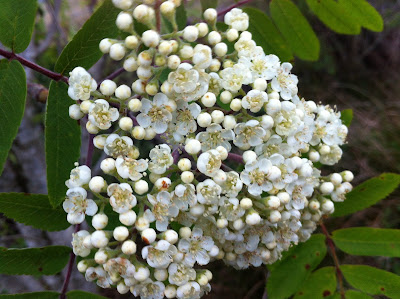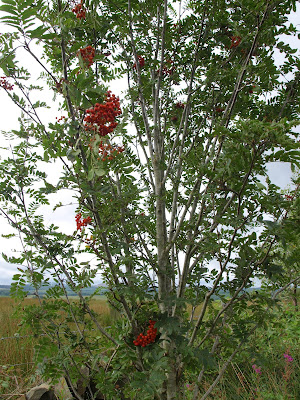Rowan (Sorbus aucuparia) is a small deciduous tree or shrub belonging to the Rosaceae family. It is also known as European mountain ash, mountain ash, wicken tree, wich tree, wicky, wiggan tree and quicken tree. It is the best known Sorbus species and is native to the British Isles, northern and western Europe.
Growing methods
The rowan will naturally propagate via seed dispersal usually with the help of wild birds in the area. If you spot one rowan tree, there will likely be others in the vicinity.
Trees can be propagated using softwood cuttings or by seed. If growing by seed, sow fresh ripe seed immediately in pots under cover or outside. If growing stored seed, they need to undergo cold stratification for 3-4 months. Once the seedlings are large enough to handle place in large pots and then plant them out in their permanent positions in the second year.
The beautiful creamy-white clusters of flowers can be seen from May until June. The bright red berries ripen from August to September. They are very hardy trees and can grow up to 20 metres in height. They can be planted as a shelter belt, as a specimen tree, in a wildlife garden or woodland setting. They tolerate maritime exposure and atmospheric pollution, and are very low maintenance. Trees may be affected by aphids, blister mites, sawflies, canker, silver leaf and fireblight.
Other uses
This is a great tree for wildlife. The leaves are eaten by caterpillars and moths. The flowers provide pollen and nectar for pollinating insects including bees. The fruit is popular in the autumn and winter months as a food source for birds.
The rowan tree is a sacred tree and has historically been used as a spiritual protector. It was planted near houses to ward off evil. The hard fine-grained wood has been used to make spinning wheels, tools, walking sticks, pegs and dowsing rods as well as being popular for carving, wood turning and coppicing. The bark, flowers and fruit are used medicinally. An oil can be obtained from the seed. All parts of the tree can be used to obtain tannin and a black dye.
 |
| Rowan (Sorbus aucuparia) |
Growing methods
The rowan will naturally propagate via seed dispersal usually with the help of wild birds in the area. If you spot one rowan tree, there will likely be others in the vicinity.
Trees can be propagated using softwood cuttings or by seed. If growing by seed, sow fresh ripe seed immediately in pots under cover or outside. If growing stored seed, they need to undergo cold stratification for 3-4 months. Once the seedlings are large enough to handle place in large pots and then plant them out in their permanent positions in the second year.
 |
| Rowan (S. aucuparia) flowers |
The beautiful creamy-white clusters of flowers can be seen from May until June. The bright red berries ripen from August to September. They are very hardy trees and can grow up to 20 metres in height. They can be planted as a shelter belt, as a specimen tree, in a wildlife garden or woodland setting. They tolerate maritime exposure and atmospheric pollution, and are very low maintenance. Trees may be affected by aphids, blister mites, sawflies, canker, silver leaf and fireblight.
 |
| Rowan is a small tree but big for wildlife |
Other uses
This is a great tree for wildlife. The leaves are eaten by caterpillars and moths. The flowers provide pollen and nectar for pollinating insects including bees. The fruit is popular in the autumn and winter months as a food source for birds.
The rowan tree is a sacred tree and has historically been used as a spiritual protector. It was planted near houses to ward off evil. The hard fine-grained wood has been used to make spinning wheels, tools, walking sticks, pegs and dowsing rods as well as being popular for carving, wood turning and coppicing. The bark, flowers and fruit are used medicinally. An oil can be obtained from the seed. All parts of the tree can be used to obtain tannin and a black dye.
Warning
Plants for a Future report that the seeds probably contain hydrogen cyanide which can cause respiratory failure and death. However, unless the seeds are very bitter, they should be safe in reasonable quantities. If using the seed, further investigation as to a safe quantity is highly recommended.
Raw edible parts
Rowan fruit, rich in vitamin C and anti-oxidants, is best after the first frosts of the season and can be eaten raw or dried. However, the fruit is often very tart and should not be eaten raw in large quantities. Fruit can be dried and added to flours.
The highly perfumed flowers and leaves can be made into a tea. The leaves turn out to be as perfumed as the flowers. Add a few sprigs of flowers or a handful of leaves to a teapot, pour over hot water that has just come to the boil and allow to steep for a few minutes. If you just want a brew for one person, place a sprig of flowers or a few leaves in a mug rather than make a whole pot. Lovely!
 |
| Rowan flower tea |
Traditionally, the berries have been cooked and made into jams, jellies, preserves, liquers, syrups, ale, cider and wine. The seed (with or without the outer fruit) can be dry roasted and made into a coffee substitute - see Warning above.
Thanks. Will horses, catte or sheep eat the leaves?
ReplyDeleteAs far as we know there is no known toxicity to horses, sheep or cattle. Whether animals will eat the leaves or not is another matter! Some horses we know nibble the leaves.
ReplyDeleteThanks. Id confirmed
ReplyDeleteDo the seeds contain amygdalin, as in other members of the rose family? If so, the coffee substitute could be risky.
ReplyDeleteSeeds from the Roseaceae family do contain hydrogen cyanide, sometimes in quite high levels. We have added a warning to the article. Thank you for pointing this out.
Delete